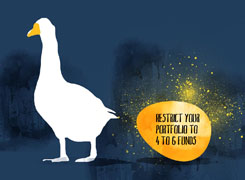Omkeshwar Singh | Answer |Ask -Follow
Head, Rank MF - Answered on Nov 20, 2019

Dear Sir, please advice. My MF portfolio is predominantly dominated by midcaps. I have SIPs in the following funds:
1. HDFC Midcap Opportunity Fund (G): Rs 10,000 (Since 2013)
2. DSP Blackrock Midcap Fund (G): Rs 10,000 (Since 2015)
3. Canara Robeco Emerging Equity: Rs 10,000 (Since 2017)
4. ICICI Prudential Focused Bluechip Equity Fund - G (Since 2017)
Should I continue with these or need some reshuffling? I would grateful if you could kindly advise me on this.
| Name of the Fund | Category | RankMF Star Rating |
| HDFC Midcap Opportunity Fund (G) | Equity - Midcap Fund | 3 |
| DSP Blackrock Midcap Fund (G) | Equity - Midcap Fund | 4 |
| CanaraRobeco Emerging Equity | Equity - Large & Midcap Fund | 4 |
| ICICI Prudential Focused Bluechip Equity Fund - G | Equity - Large Cap Fund | 3 |
Continue with the 4-star rated ones, for other 3 you may consider the ones below:
Large cap Suitable options considering quality and value for money at present levels is Mirae Asset Large Cap Fund
Midcap: Suitable options considering quality and value for money at present levels are Motilal Oswal Midcap 30, DSP Midcap and Axis Midcap
You may like to see similar questions and answers below
Omkeshwar Singh | Answer |Ask -Follow
Head, Rank MF - Answered on Aug 08, 2022
Omkeshwar Singh | Answer |Ask -Follow
Head, Rank MF - Answered on Aug 08, 2022
Omkeshwar Singh | Answer |Ask -Follow
Head, Rank MF - Answered on Aug 08, 2022
Sanjeev Govila | Answer |Ask -Follow
Financial Planner - Answered on Mar 28, 2024
Ramalingam Kalirajan |10908 Answers |Ask -Follow
Mutual Funds, Financial Planning Expert - Answered on Jan 09, 2025
Ramalingam Kalirajan |10908 Answers |Ask -Follow
Mutual Funds, Financial Planning Expert - Answered on Dec 20, 2025
Ramalingam Kalirajan |10908 Answers |Ask -Follow
Mutual Funds, Financial Planning Expert - Answered on Dec 20, 2025
Naveenn Kummar |237 Answers |Ask -Follow
Financial Planner, MF, Insurance Expert - Answered on Dec 20, 2025
Ramalingam Kalirajan |10908 Answers |Ask -Follow
Mutual Funds, Financial Planning Expert - Answered on Dec 19, 2025
Nayagam P P |10859 Answers |Ask -Follow
Career Counsellor - Answered on Dec 19, 2025
Ramalingam Kalirajan |10908 Answers |Ask -Follow
Mutual Funds, Financial Planning Expert - Answered on Dec 19, 2025
Ramalingam Kalirajan |10908 Answers |Ask -Follow
Mutual Funds, Financial Planning Expert - Answered on Dec 19, 2025
Ramalingam Kalirajan |10908 Answers |Ask -Follow
Mutual Funds, Financial Planning Expert - Answered on Dec 19, 2025
Radheshyam Zanwar |6751 Answers |Ask -Follow
MHT-CET, IIT-JEE, NEET-UG Expert - Answered on Dec 19, 2025
Radheshyam Zanwar |6751 Answers |Ask -Follow
MHT-CET, IIT-JEE, NEET-UG Expert - Answered on Dec 19, 2025


























